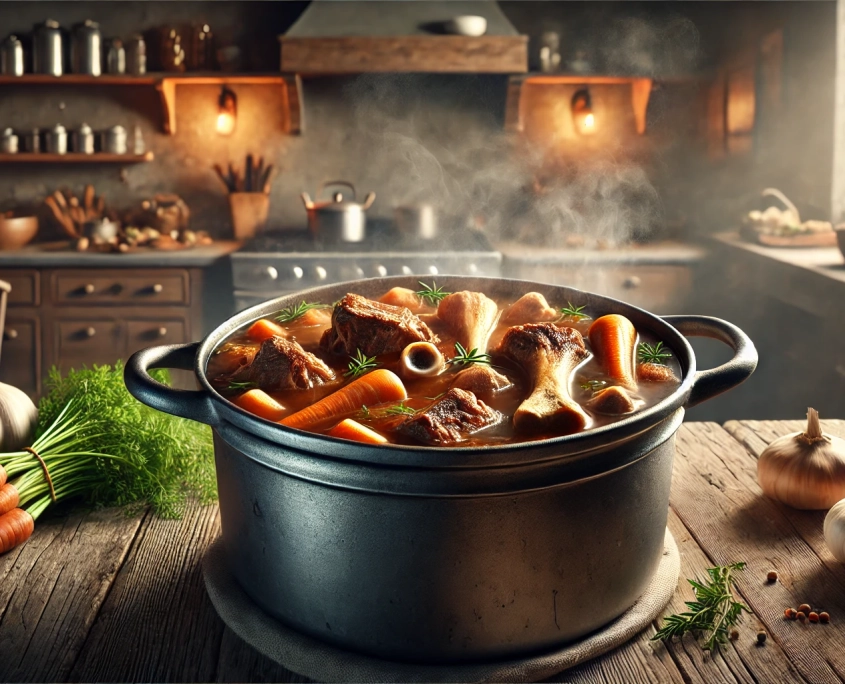How to Make Bone Broth: A Simple Guide

Ingredients:
Bones: Use beef, chicken, pork, or fish bones. You can mix types if desired.
Vegetables: Carrots, celery, and onions.
Acid: Apple cider vinegar or lemon juice (helps extract minerals from the bones).
Water: Enough to cover the bones in your pot.
Salt and Pepper: To taste.
Herbs and Spices (optional): Garlic, bay leaves, thyme, rosemary, etc.
Equipment:
Large Pot: Preferably a stockpot or a slow cooker.
Strainer: To strain the broth.
Storage Containers: For the finished broth.
Steps:
Prepare the Bones:
Roast Bones (optional but adds flavor): Preheat your oven to 400°F (200°C).
Place the bones on a baking sheet and roast for 30-40 minutes until browned.
Add Bones and Vegetables to Pot:
Place your bones in the pot or slow cooker.
Add roughly chopped vegetables (carrots, celery, onions).
Add a splash (2 tablespoons) of apple cider vinegar or lemon juice.
Cover with Water:
Pour enough water into the pot to cover the bones and vegetables by about 1-2 inches.
Simmer:
Stovetop: Bring to a boil, then reduce to a low simmer. Cover and let it cook.
Chicken bones: 12-24 hours.
Beef or pork bones: 24-48 hours.
Fish bones: 4-6 hours.
Slow Cooker: Set on low and let it cook for the same time ranges as above.
Skim Foam (optional):
During the first few hours of simmering, skim off any foam that rises to the top.
Add Salt and Spices:
Add salt and pepper to taste.
Add herbs and spices during the last hour of cooking if using.
Strain the Broth:
Once cooking is complete, let the broth cool slightly.
Strain through a fine-mesh strainer to remove bones and vegetable solids.
Cool and Store:
Let the broth cool completely.
Transfer to storage containers and refrigerate.
For longer storage, freeze the broth in portions.
By following these steps, you’ll be able to make delicious, nutrient-dense bone broth at home.
Tips:
Use Good Quality Bones: Grass-fed beef bones, organic chicken bones, etc.
Add Feet and Joints: These contain more collagen, which is beneficial for the broth.
Adjust Cooking Time: The longer you cook, the richer and more nutritious the broth.
Storage: Refrigerated broth lasts about a week. Frozen broth can last several months.

Benefits of Drinking Bone Broth
Rich in Nutrients:
Collagen and Gelatin: These proteins support joint health, skin elasticity, and gut healing.
Amino Acids: Bone broth contains essential amino acids like glycine and proline, which are vital for overall health.
Minerals: Bone broth is a good source of minerals such as calcium, magnesium, and phosphorus, which are important for bone health.
Supports Gut Health:
Healing the Gut Lining: Gelatin in bone broth can help seal openings in the gut lining, which is beneficial for those with leaky gut syndrome.
Promotes Healthy Digestion: The amino acids and gelatin can help improve digestion and nutrient absorption.
Joint Health:
Reduces Joint Pain: The collagen and gelatin can help reduce joint pain and inflammation, supporting overall joint health and mobility.
Boosts Immune System:
Nutrient-Dense: The nutrients in bone broth can help strengthen the immune system and aid in recovery from illness.
Enhances Skin Health:
Improves Skin Elasticity: Collagen can improve skin hydration and elasticity, reducing wrinkles and promoting a youthful appearance.
Supports Sleep and Mental Health:
Amino Acids for Sleep: Glycine, found in bone broth, can promote better sleep and has a calming effect on the nervous system.
Mental Health: The nutrients in bone broth support overall brain function and mental health.
Why Drink Bone Broth Three Times a Week?
Consistent Nutrient Intake:
Drinking bone broth regularly ensures a steady intake of its beneficial nutrients, which supports long-term health and well-being.
Convenience and Versatility:
Bone broth is easy to make in large batches and can be incorporated into various meals, making it a convenient way to boost your nutrient intake.
Prevents Nutrient Deficiencies:
Regular consumption can help prevent deficiencies in important minerals and amino acids that are often lacking in modern diets.
Supports Active Lifestyles:
For those with active lifestyles or engaging in physical exercise, bone broth provides the necessary nutrients to support recovery and reduce joint pain.
In Summary:
Drinking bone broth three times a week is a beneficial practice that supports overall health. It provides essential nutrients that promote gut health, joint health, immune function, skin health, and mental well-being. Incorporating bone broth into your diet is a simple and effective way to enhance your nutrition and maintain a healthy lifestyle.
Creative Variations:
Herbs and Spices:
Fresh Herbs: Add fresh herbs like rosemary, thyme, parsley, or cilantro towards the end of the simmering process.
Spices: Incorporate whole spices like star anise, cloves, cinnamon sticks, or cardamom pods for an aromatic twist.
Aromatics:
Ginger and Turmeric: Add slices of fresh ginger and turmeric roots to infuse the broth with anti-inflammatory properties and a warming flavor.
Garlic: Use roasted garlic cloves for a deeper, sweeter garlic flavor.
Vegetables:
Mushrooms: Add dried or fresh mushrooms like shiitake or maitake for an umami boost.
Sea Vegetables: Include kombu or wakame for added minerals and a hint of the sea.
Acidic Components:
Apple Cider Vinegar: While this is common, you can also use a splash of balsamic vinegar or rice vinegar for a different acidity profile.
Citrus Zest: Add lemon or lime zest for a fresh, bright note.
Liquid Enhancers:
Coconut Milk: Stir in a small amount of coconut milk for a creamy texture and exotic flavor.
Wine: Use a splash of white or red wine to deglaze the pot before adding water for depth of flavor.
Additional Nutrients:
Bone Marrow: Include bone marrow bones and scrape out the marrow into the broth for extra richness.
Collagen Peptides: Add collagen peptides or gelatin powder to boost the collagen content.
Salt:
Miso Paste: Stir in a spoonful of miso paste towards the end for a savory, salty complexity.
Sea Salt: Use high-quality Celtic sea salt or Himalayan pink salt.
Cooking Techniques:
Roasting: Always roast your bones and vegetables before simmering to develop deeper flavors.
Slow Cooker or Instant Pot: Consider using these tools to ensure a consistent, low-temperature simmering process for maximum nutrient extraction.
Serving Suggestions:
Garnishes: Top your bone broth with fresh herbs, green onions, or a squeeze of fresh lemon juice when serving.
Special Ingredients:
Apple: Add a whole apple, halved, to the broth for a subtle sweetness.
Tomato Paste: Incorporate a spoonful of tomato paste for umami and slight acidity.
